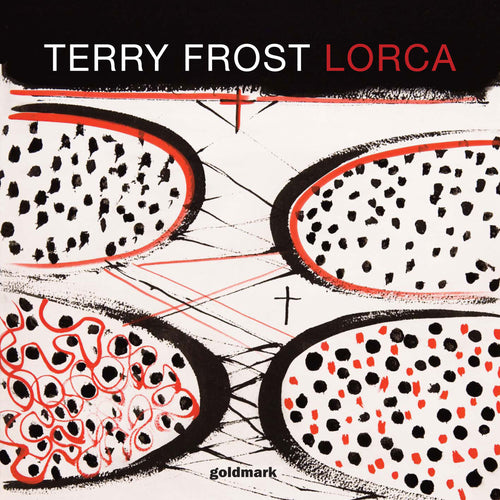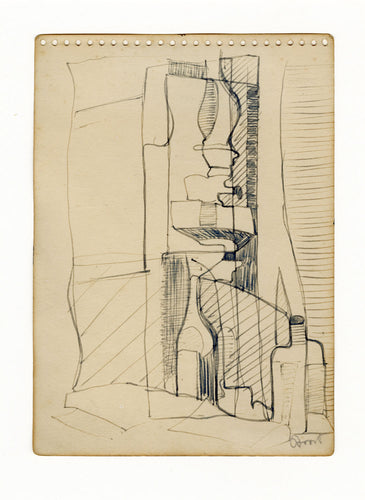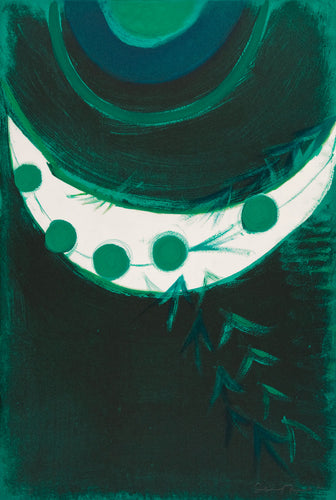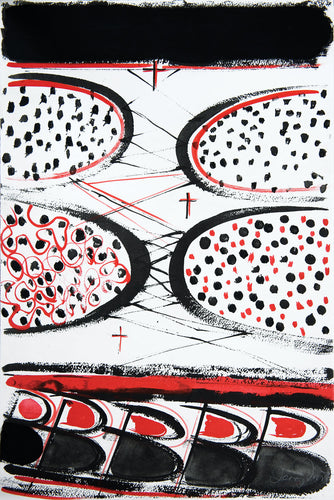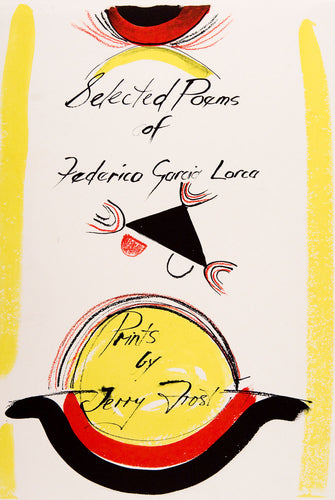
La Soltera en Misa (The Spinster at Mass)
Black was Frost’s first colour. He found it in Stalag 383 as a Prisoner of War, where he spent most of his four years of confinement learning to draw on scraps of paper and hacked-up pillow cases. With parcels of oil paints delivered by the Red Cross and ochre slipped to him by a kindly German guard, mixed with the oily residue of sardine tins, his palette soon expanded and, before long, he was making sketches and small portraits to trade for rations. He was quickly discovered by fellow detainee Adrian Heath, an established artist who encouraged Frost to take up art as a vocation after the war. Having returned demobbed in 1945, he determined to become an artist, to the great bemusement of his working-class family, and enrolled at the Camberwell School of Art on a veteran grant.

Claro de Reloj (Pause of the Clock)
It was in the German camp too, where tattered copies of Keats and Milton were ‘more plentiful than bread’, that Frost had found a love of the written word. Spurred on by the liberal tutelage of Victor Pasmore, himself in the midst of an epiphany of abstraction, Frost began to develop an emphatic visual language of shapes, circles and spirals in his own poetic canvases.

Thamar Y Amnon (Thamar and Amnon)
Flitting between London and St Ives, where a commune of British artists formed by Ben Nicholson and Barbara Hepworth had begun to abstract local landscapes and sea-scenes, Frost became a regular of the Cornish town. He began an assistant in Hepworth’s sculpture studio, and by the late 1980s had become one of Britain’s preeminent abstract artists, his sense of form and colour purified to curvilinear blocks of vibrant, primary paint.

Variacón (Variations)
Frost discovered Lorca in the mid-1970s. Or rather, he first discovered the Duende, what Lorca defined as those moments in reality that are so heightened, and felt with such intensity, that one is forced to confront the significance of the experience. For Lorca, it was to be so moved as to become aware of one’s mortality, to have to grapple from the very depths of the soul with one’s emotional response: ‘[It is] a power, not a work. It is a struggle, not a thought. I have heard an old maestro say, ‘The Duende is not in the throat; the Duende climbs up inside you, from the soles of the feet.’…It is not a question of ability, but of true, living style, of blood, of the most ancient culture, of spontaneous creation…everything that has black sounds in it, has Duende.’

Canción de Jinete (The Rider's Song)
Frost’s own Duende came to him in Spain in a fish market, where the stall-holders, draped in black – ‘My god, I thought, what are they all doing in black? I thought people would wear white for the heat’ – offered him their catch: ‘They slithered a great silver fish in front of me! Then they began to carve it up. What with the sound of the Spanish, which was beautiful to me, and then this silver fish – it was a magic moment.’

San Rafael (Córdoba)
For fifteen years, Frost read and re-read Lorca’s poetry, in which he found a mirror of his Duende experience: ‘With Lorca I travel on a ride to no-man’s land. There I am; my emotions take on a new distance and the extent between life and death becomes forever.’ He began to paint what he read; not illustrations, but expressions of love. Lorca had commanded, ‘You must not read Goncora, you must love him’, and so he learnt to love Lorca, until the poet’s words became so ingrained that it was not specific lines or stanzas that he sought to represent but a tugging of the heart, a ‘total feeling’ encompassing word, image, and experience. To black and white he added red, the holy trinity of Frost’s prime colours: ‘Black and Red become a symbol for death and life, lust, passion, tenderness, fear, love. The black and white of the words on paper become gods like the sun and the moon.’

La Luna Asoma (The Moon Rising)
By 1989, Frost had developed his Lorcan theme to the point where he wished to dedicate a whole suite to the Spaniard's poetry, an assembled box of printed images that would encapsulate his cohabitation with these words over the past two decades. Eleven poems were chosen, with eleven etchings to accompany. In their strength of colour, form, and harmonious arrangement, their technical complexity, involving multiple processes including hand-colouring and embossing, they are undoubtedly the most accomplished and coherent of Frost’s many portfolios of prints.

Lament for Ignacio Sánchez Mejías
Housed in a black cloth Solander box, the suite opens with Lorca’s lament for the fallen matador Ignacio Sanchez Mejias: it is a catastrophically powerful first image, in which the bull’s horn – shaped not like a horn, but the familiar, Frostian hull of an underworld ferryman’s boat – gores the page, bespattering white paper with crimson blood under the faint halo of a pounding Spanish sun.

Es Verdad (It Is True)
As one turns each print over to the next, the intensity of Frost’s poetic Duende vibrates in each subsequent image. There is sophistication in the range of colour, that shifts from flat black and red to deep, Delphian blues and greens in Es Verdad (‘It is True’) and Arbole, Arbole (‘Tree, oh Tree’). Frost’s signature arcs, circles and whirling spirals spin from print to print, finding their fullest resonance in the lush watercolour that supplements this edition (only 15 of all 50 portfolios were issued with such originals).

Arbole, Arbole (Tree, Tree)
In Lorca’s poetry, colour and emotion are inextricably intertwined. ‘Colour is the eye’s music’, he once wrote; and if so, then Frost’s suite is the swansong he never heard, the echoing forms, the vital breath of colour that gives new shape to his phrases. It remains amongst the most intimate and affecting of the twentieth century’s livres d’artistes, confirmation – if any were needed - of Frost’s deserved place at the head of the British abstract canon.

